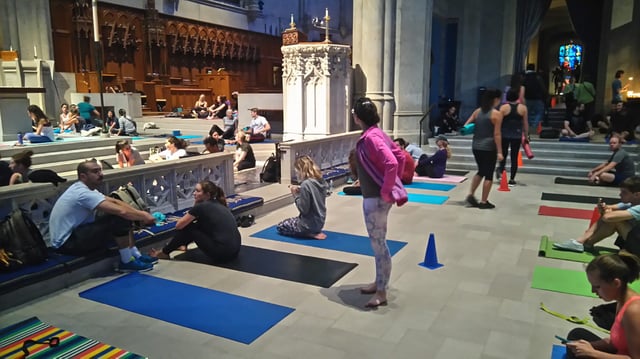Yoga Marketing - How to Get Google to Rank Your Yoga Site
As a yoga teacher, the organization process can be overwhelming. With 34% of Americans saying they are likely to practice yoga in the next 12 months, it really is a booming market.
Especially here in San Francisco, where I moved 3 months ago. The city is full of awesome yoga studios and it made so much sense to start my own practice, despite not having any prior experience. And I've got to tell you, it is awesome! But enough about me.
You want to know how to improve your yoga marketing and attract more people to your yoga classes and retreats!

One option is to invest time into increasing your online presence by marketing your yoga site online. In particular – to improve your SEO efforts to get to the top of Google Search results.
SEO (Search Engine Optimization) can be complicated. You have enough to worry about, and SEO gets continually more complex thanks to ongoing changes at Google.
With the majority of yoga teachers communicating with their current or prospective students using social media, maybe improving SEO doesn’t feel like a necessity for you. You normally don’t see immediate results on your SEO investments – it might take months to see the real impact.
However, it’s still important to nail the basics when you want to stand out. If people are searching for yoga retreats, classes, or yoga studios and your website comes up, then the more likely you are to get more clicks and hopefully generate more customers.
But how do you get your yoga website to show up in Google? Let me introduce you to five basic SEO tricks you can apply to your yoga marketing strategy.
5 SEO Tricks To Nail Your Yoga Marketing
1. Page Titles and Description
Page titles are a very important aspect of SEO and that is why it is first on the list. Each page needs to have a unique page title that accurately describes the page’s content. You should be brief and descriptive and help the user understand what the page is about and why they should click on it.
Home Page Title:
The title for your homepage can list the name of your website/business and could include other bits of important information like the physical location of the business or maybe a few of its main focuses or offerings. It shouldn't be longer than 70 characters, otherwise, Google will cut it off in the search results.
Posts & Pages Title:
The title of other posts and pages on your website should accurately describe what the page is about and be attractive to the searcher.
Description:
A page’s description meta tag is also very important. It gives users, Google, and other search engines a summary of what the page is about. Google recently changed the length from 160 to up to 320 characters, but you should still stick to the principles of writing a good description.
The guidelines are:
- Always provide a unique description for all pages and posts.
- Avoid repeating your page title in the description.
- Try to use the description as a way to ‘advertise’ your page to the reader so that they click on your title and visit the page. The more people click the better Google will consider the page, and push it up the rankings.
2. Optimize for Local Searches
When people are searching for a local yoga studio or business then it's important that yours comes up! Create a “Google My Business” page (for free) with your studio’s address, phone number, hours of operation, and company information listed on it.
This allows you to control what Google shows users in search results and makes finding the location of your studio on Google Maps easier. You are also able to respond to customer reviews, post photos, and gain insight into how people found your business through Google.

3. Create Valuable Content
Search engines rank websites higher when they provide useful information.
A yoga site that simply has a list of offerings like classes or retreats generally ranks lower than a similar site that also provides useful information. Having a blog is a great way for yoga businesses to improve their SEO rank.
You can write about the benefits of practicing yoga, the types of classes you are offering or about the destinations you are organizing retreats to. Offer value to your current and future customers and they will appreciate it. So will Google.

4. Internal Links
Use the links within your site to encourage search engines to index more of your pages. Adding rich interlinks within your site’s text to other pages on your site can entice a search engine spider to visit more of your pages, especially if they contain related information to the page they just came from.
E.g write a blog post on the yoga classes you are offering and you can link it to a blog post you are writing about interesting facts on yoga studios and retreats. (See what I did there?) Act as a first-time visitor to your website, and ask yourself where it makes sense to link to a different page. This will help both search engines and visitors explore more of your website.

5. Outbound Links
Give your visitors a more powerful user experience and add more value by creating outbound links to useful sites. Outbound links to other websites are also interesting to search engine spiders, especially if the sites you are linking to contain information related to your website.
E.g you can use different yoga sites as resources while writing blog posts and then link to them. The search engines will thank you for your helpfulness.

There is a lot more to a complete SEO strategy than what I've outlined above, but following these guidelines is enough to get you started with improving the SEO of your yoga site. A comprehensive yoga marketing strategy is important when you're trying to reach your target customer, and these SEO tips for yoga businesses will help you get closer to your goals.
Any questions? Feel free to email me for more information: sander@wetravel.com
New resources, straight to your inbox
We’re committed to your privacy. WeTravel uses the information you provide to us to contact you about our relevant content, products, and services. You may unsubscribe at any time.







